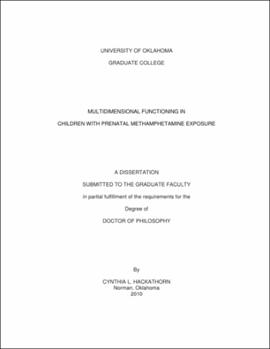| dc.description.abstract | Methamphetamine is one of the most neurotoxic and addictive drugs of abuse. While prenatal exposure to all illicit drugs is considered detrimental, it might be argued that because of the polydrug nature of methamphetamine and the harmful effects that physical exposure to the substance can produce, it is perhaps even more damaging, or damaging in a different manner, than other drugs when used by pregnant women. Few studies have focused on the effects of prenatal exposure to methamphetamine alone or methamphetamine when combined with or compared to other substances. Additionally, no study has focused solely on the differences in the cognitive, language, motor, emotional functioning, behavioral functioning, and head circumference of young children prenatally exposed to methamphetamine only, young children prenatally exposed to methamphetamine plus other substances, and young children prenatally exposed to other substances not including methamphetamine. The present study attempted to address these issues by utilizing archival data from a specialty clinic in a large Southwestern city to which children, aged 1-month to 7-years, were referred specifically because of their prenatal exposure to substances. 1,556 records of children met inclusion criteria, although many of the records did not include data from all assessment measures. The subjects received a standardized battery of tests to determine their cognitive, language, motor, emotional and behavioral functioning, and physical development. Although no significant differences were found between exposure groups on scores of cognitive development, emotional development, and behavioral development, a nonsignificant difference (p< .069) was found for language development. Additionally, significant differences were found between exposure groups on scores of motor development and head circumference measurements. This suggests that prenatal exposure to methamphetamine is as harmful as prenatal exposure to other substances; however, it does not appear to cause increased cognitive, language, emotional, or behavioral damage, nor does it appear to compound the effects of other drugs. However, findings of significant differences in the motor development and head circumference categories seem to indicate that these areas may be at risk of increased damage through prenatal exposure to methamphetamine. The current study was limited by lack of a control group, an inability to control for environmental exposure to drugs and alcohol, and retrospective, maternal and second-party report. | |
